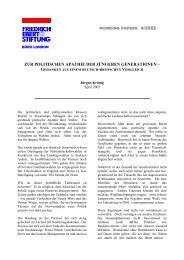Where Now for European Social Democracy? - Policy Network
Where Now for European Social Democracy? - Policy Network
Where Now for European Social Democracy? - Policy Network
You also want an ePaper? Increase the reach of your titles
YUMPU automatically turns print PDFs into web optimized ePapers that Google loves.
54WHERE NOW FOR EUROPEAN SOCIAL DEMOCRACY?should rather confront the challenge and concentrate on designing,and making socially acceptable, institutions that can be conduciveto both.Macroeconomic policy is a third example. The current <strong>European</strong>set-up has been inspired by the need to protect the ECB from thedanger of political interference that would have threatened pricestability. This legitimate objective has often led to relegate otherobjectives to second rank status, such as the need to ensureappropriate fiscal stabilisation and the need to establish amacroeconomic set-up that is at the same time conducive to growthenhancingre<strong>for</strong>ms. In view of the inadequate growth per<strong>for</strong>manceof the recent years, many social democrats rightly question theappropriateness of the EU fiscal discipline framework. Yet any re<strong>for</strong>mof this framework must be based upon the recognition that fiscalresponsibility is an essential tenet of a well-functioning monetaryunion. Only after this reality is unequivocally acknowledged canfruitful discussions be started on the desirable re<strong>for</strong>ms of the Stabilitypact and macroeconomic policy coordination procedures.Last but not least, the role of Europe in this very process ofgrowth-enhancing re<strong>for</strong>ms must be assessed. Two views of <strong>European</strong>integration coexist among social democrats, which are increasinglydifficult to combine. The first holds that what <strong>European</strong> integration isessentially about is the building of a collective economic sovereignty.According to this view, states may have to surrender national economicsovereignty but it is in fact transferred to a higher, federal level. Thealternative view maintains that the essence of <strong>European</strong> integration isto create a level playing field <strong>for</strong> policy competition among states. Itis thus a process through which the best and most successful policiesemerge. Those two views have long coexisted in Europe, butcompromises are increasingly difficult to reach, as indicated by theongoing dispute on tax coordination and harmonisation. This debatehas a bearing on growth-enhancing policies: those who favour thefirst model naturally propose that the EU takes on explicitresponsibilities in this domain, <strong>for</strong> example through a change in thestructure of its budget that would lead to more Community financing<strong>for</strong> research, infrastructure and innovation and through a refined



